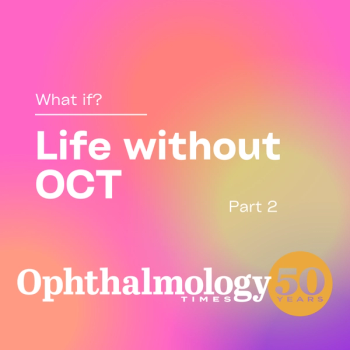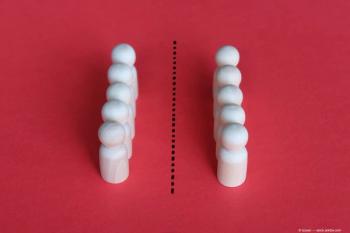
- Ophthalmology Times: March 2024
- Volume 49
- Issue 3
Technology pinpoints the retinal damage occurring in IRDs
Electrophysiologic testing combined with structural imaging to zero in on issues.
Reviewed by Minzhong Yu, PhD, MMed
Diagnosing inherited retinal diseases (IRDs) poses a challenge to clinicians because of their genetic and clinical heterogeneity. Technological advances in
However, when combined with electrophysiologic testing, the information garnered is stepped up a notch, according to the authors of a recent review.
The investigators, Yulia Haraguchi; Tsun-Kang Chiang, MD; and Minzhong Yu, PhD, MMed, are from the Department of Ophthalmology and Visual Sciences, University Hospitals, Case Western Reserve University, in Cleveland, Ohio. They underscored that incorporating electrophysiologic testing with multimodal imaging “provides useful information for diagnosis and characterization of disease, potentially in patients that are presymptomatic or have dysfunction/degeneration in isolated regions of the retina.”
The electrophysiologic tests, in other words multifocal electroretinography (mfERG), full-field ERG (ffERG), electrooculography (EOG), pattern electroretinography (PERG), and visual-evoked potential (VEP), can identify the sites of the retinal damage and the cell types involved in the visual degenerative process,1 the authors explained.
In their recent review, they described the potential that electrophysiology testing provides to further understand the common and rare nonmacular IRDs and how such testing may facilitate future early detection, prognostic prediction, and therapeutic monitoring. The extensive review focused on retinitis pigmentosa (RP), progressive cone and cone-rod dystrophy, bradyopsia, Bietti crystalline dystrophy, late-
onset retinal degeneration, and fundus albipunctatus. This report focuses on electrophysiologic testing in RP.
RP symptoms and types
RP is the most common of the IRDs, with a prevalence of 1 in 4000 individuals worldwide.2,3
The disease causes rod photoreceptor degeneration that manifests initially with decreased night vision and difficult dark adaptation; these are followed by progressive cone photoreceptor and retinal pigment epithelial (RPE) degeneration and progressive visual field (VF) loss.4 In addition to night blindness, the clinical picture includes tunnel vision and gradual central vision loss depending on the genes and alleles involved.4
In RP, the vision loss generally begins in the adolescent years, but this can vary by RP subtype. The authors explained that most RP cases have nonsyndromic, that is to say isolated, visual symptoms, and 20% to 30% of patients with RP are syndromic and associated with nonocular conditions that include4 most often Bardet-Biedl syndrome and Usher syndrome.
Nonsyndromic RP includes genetically heterogeneous disorders of which 15% to 25% of cases are autosomal dominant in nature with about 26 gene mutations; RHO,5 PRPF31,5 and RP1 genes6 are the most commonly affected. Five to twenty percent of cases are autosomal recessive, 5% to 15% are X linked, and 40% to 50% are simplex forms. More than 70 genes and 300 mutations are implicated.7
In the most severe RP form, X linked, nyctalopia occurs during childhood, followed by continued VF reduction; the severe decrease in visual acuity (VA) occurs by the fourth decade of life.8 A nonsense mutation of the RPGR gene, which regulates photoreceptor cilia function, is most often associated with X-linked RP; another common mutation is in the RP2 gene that affects protein transport in photoreceptor cells.9
Autosomal recessive RP is rare and causes only 1% of all cases. The autosomal recessive mutations in the PDE6 complex can be associated with early-onset RP affecting rod phototransduction and intracellular cGMP levels,7 the authors explained. Isolated cases are characterized by individuals who do not have affected family members and display clinical heterogeneity.10
“The diversity of pathogenesis of genetic defects associated with RP poses significant challenges in preventing the onset and advancement of the condition and in restoring vision,” the authors wrote. “There is no current pharmacologic therapy that has been clearly prove[d] for efficacy, although some neuroprotective substances such as neurotrophic factors, vitamin A, and other antioxidants may delay photoreceptor and RPE cell loss.”11
Additionally, gene therapy, stem/retinal cell transplantation, and visual cortex prosthesis have been in development in recent decades.11 The most successful progress in treatment in recent years is the RPE65 gene therapy, which has been successfully used in clinical patients.12-24
Examination findings
Fundus examinations of patients with RP show bone spicule pigmentation, attenuated retinal vessels, and waxy pallor of the optic nerve.4 The optic nerve head may appear waxy in early disease due to hyperemia and may progress to significant pallor in advanced disease with axonal loss and glial cell response.25,26 OCT shows disruption and loss of the ellipsoid zone, loss of choroidal vasculature, cystoid macular edema, and decreased retinal thickness.27-29
The investigators pointed out that during the diagnostic process, ffERG may detect early characteristic photoreceptor degeneration even before patients notice symptoms, making it useful to diagnose RP.2 ffERG differentiates between predominantly rod or cone system dysfunction and between generalized outer and inner retinal dysfunction.
Other research findings also have reported the following results that support electrophysiology. In patients with RP without deteriorated VA, the N1 and N1P1 mfERG components show central retinal function preservation, but the components become severely reduced outside zone 2 of the retina.30 mfERG shows delayed latency and decreased amplitude compared with controls that correspond to VF losses.31 The decreased amplitude of the central segment of mfERGs and increased latency of mfERG in the central retina are correlated significantly with VA loss.32 Additionally, OCT shows decreased focal macular ERG amplitudes before the ellipsoidal zone thinning in early-stage RP, indicating that the focal macular ERG can be an earlier and reliable indicator of macular dysfunction.33
However, mfERGs, like PERGs, may not be recommended as a primary outcome measure in patients with advanced RP and nonrecordable ffERG because of the low responses in all tested areas.34 EOG measures the RPE potential in response to dark and light conditions and shows advanced RP is associated with a reduced light peak to dark trough ratio.27,35-37
The combination of mfERG and mfVEP helps determine the impact of regional retinal function on the visually evoked cortical activity, because the VEPs are generated primarily in the visual cortex and may be affected by abnormalities in the visual pathway.38 The mfERGs usually confirm preserved central retinal function in RP, with severely reduced function outside of the central retina, which may not be reflected by ffERGs.39
The PERG measures central retinal function and shows abnormal values with affected VA.40 PERG evokes retinal responses with 2 components (positive P50 and negative N95) using a high-contrast checkerboard reversal pattern stimulus.41 In RP, the PERG shows significantly lower P50 and N95 amplitudes, indicating macular photoreceptor and ganglion cell activity, respectively,42,43 and correlates with data from histologic studies that show significant reductions in the number of macular ganglion cells in RP.44,45
Reduced P50 amplitudes also are associated with reduced VA and reduced length of the ellipsoid layer on OCT, providing objective measures to monitor disease progression.46 Pattern VEPs (PVEPs) in RP show characteristic N75, P100, and N135 peaks with longer implicit times.42 PVEPs may offer an accurate and reliable assessment of residual foveal functions, as patients with advanced RP may have a low percentage of successful or recordable ffERG or PERG signals.42,43,47
The full-field stimulus threshold (FST), an alternative for measuring dark-adapted light sensitivity in patients with low vision, represents the retinal sensitivity of the most sensitive parts of the functioning retina without identifying the areas from which the signal originates. In RP, FST quantifies the wide range of visual impairment representing the range of visual function, depending on the early to late stages of disease. FST results also are correlated with the ffERG amplitude and VF test results and provide an alternative to those tests in patients who cannot undergo a VF test or have nondetectable ERGs.48
“Electrophysiology testing may be a valuable tool in the early diagnosis and monitoring of RP, as ffERG can identify early characteristic photoreceptor degeneration before patients notice symptoms,” the authors concluded. “This is useful in many cases of early RP and other IRDs in which the retina may appear normal despite clinical symptoms and VF defects. mfERG and PERG provide objective evaluations of residual cone function in RP, which can provide guidance for patient prognoses as it relates to progressive blindness and reduced vision-related quality of life.45 mfERG, when combined with OCT and VEP, can provide useful information in monitoring macular function in RP.32 Using a combination of structural imaging and electrophysiologic investigations will likely provide better estimations of retinal function in patients [with RP].”
Minzhong Yu, PhD, MMed
Yu has no financial disclosures related to the content of this article.
References:
Haraguchi Y, Chiang TK, Yu M. Application of electrophysiology in nonmacular inherited retinal dystrophies. J Clin Med. 2023;12(21):6953. doi:10.3390/jcm12216953
Hamel C. Retinitis pigmentosa. Orphanet J Rare Dis. 2006;1:40. doi:10.1186/1750-1172-1-40
Pagon RA. Retinitis pigmentosa. Surv Ophthalmol. 1988;33(3):137-177. doi:10.1016/0039-6257(88)90085-9
Verbakel SK, van Huet RAC, Boon CJF, et al. Nonsyndromic retinitis pigmentosa. Prog Retin Eye Res. 2018;66:157-186. doi:10.1016/j.preteyeres.2018.03.005
Diakatou M, Manes G, Bocquet B, Meunier I, Kalatzis V. Genome editing as a treatment for the most prevalent causative genes of autosomal dominant retinitis pigmentosa. Int J Mol Sci. 2019;20(10):2542. doi:10.3390/ijms20102542
Tsang SH, Sharma T. Autosomal dominant retinitis pigmentosa. Adv Exp Med Biol. 2018;1085:69-77. doi:10.1007/978-3-319-95046-4_15
Tsang SH, Sharma T. X-linked retinitis pigmentosa. Adv Exp Med Biol. 2018;1085:31-35. doi:10.1007/978-3-319-95046-4_8
Lyraki R, Megaw R, Hurd T. Disease mechanisms of X-linked retinitis pigmentosa due to RP2 and RPGR mutations. Biochem Soc Trans. 2016;44(5):1235-1244. doi:10.1042/BST20160148
Bravo-Gil N, González-Del Pozo M, Martín-Sánchez M, et al. Unravelling the genetic basis of simplex Retinitis Pigmentosa cases. Sci Rep. 2017;7:41937. doi:10.1038/srep41937
Dias MF, Joo K, Kemp JA, et al. Molecular genetics and emerging therapies for retinitis pigmentosa: basic research and clinical perspectives. Prog Retin Eye Res. 2018;63:107-131. doi:10.1016/j.preteyeres.2017.10.004
Papaioannou I, Owen JS, Yáñez-Muñoz RJ. Clinical applications of gene therapy for rare diseases: a review. Int J Exp Pathol. 2023;104(4):154-176. doi:10.1111/iep.12478
Audo I, Nassisi M, Zeitz C, Sahel JA. The extraordinary phenotypic and genetic variability of retinal and macular degenerations: the relevance to therapeutic developments. Cold Spring Harb Perspect Med. Published online August 21, 2023. doi:10.1101/cshperspect.a041652
Chan HW, Oh J, Leroy B. Therapeutic landscape for inherited ocular diseases: current and emerging therapies. Singapore Med J. 2023;64(1):17-26. doi:10.4103/singaporemedj.SMJ-2022-179
Farris M, Goodall S, De Abreu Lourenco R. A systematic review of economic evaluations for RPE65-mediated inherited retinal disease including HTA assessment of broader value. Int J Technol Assess Health Care. 2023 Jun 14;39(1):e38. doi:10.1017/S0266462323000326
Han J, Joo K, Kim US, et al. Voretigene neparvovec for the treatment of rpe65-associated retinal dystrophy: consensus and recommendations from the Korea RPE65-IRD Consensus Paper Committee. Korean J Ophthalmol. 2023;37(2):166-186. doi:10.3341/kjo.2023.0008
Jánossy Á, Vizvári E, Lőrincz M, Pál S, Nagy D, Benedek G, Tóth-Molnár E, Janáky M. Long-Term Follow-Up of a Family with Retinal Dystrophy Caused by RPE65 Mutation. Case Rep Ophthalmol. 2023 Sep 19;14(1):454-461. doi: 10.1159/000530086. PMID: 37901629; PMCID: PMC10601797.
Jung R, Kempf M, Holocher S, et al. Multi-luminance mobility testing after gene therapy in the context of retinal functional diagnostics. Graefes Arch Clin Exp Ophthalmol. 2023; doi: 10.1007/s00417-023-06237-4
Kiraly P, Cottriall CL, Taylor LJ, Jolly JK, Cehajic-Kapetanovic J, Yusuf IH, Martinez-Fernandez de la Camara C, Shanks M, Downes SM, MacLaren RE, Fischer MD. Outcomes and Adverse Effects of Voretigene Neparvovec Treatment for Biallelic RPE65-Mediated Inherited Retinal Dystrophies in a Cohort of Patients from a Single Center. Biomolecules. 2023 Oct 5;13(10):1484. doi: 10.3390/biom13101484. PMID: 37892166; PMCID: PMC10605275.
Ku CA, Igelman AD, Huang SJ, Vasconcelos H, da Palma MM, Bailey ST, Lauer AK, Weleber RG, Yang P, Pennesi ME. Improved Rod Sensitivity as Assessed by Two-Color Dark-Adapted Perimetry in Patients With RPE65-Related Retinopathy Treated With Voretigene Neparvovec-rzyl. Transl Vis Sci Technol. 2023 Apr 3;12(4):17. doi: 10.1167/tvst.12.4.17. PMID: 37058101; PMCID: PMC10117223.
Lorenz B, Künzel SH, Preising MN, Scholz JP, Chang P, Holz FG, Herrmann P. Single Center Experience with Voretigene Neparvovec Gene Augmentation Therapy in RPE65 Mutation-Associated Inherited Retinal Degeneration in a Clinical Setting. Ophthalmology. 2024 Feb;131(2):161-178. doi: 10.1016/j.ophtha.2023.09.006. Epub 2023 Sep 12. PMID: 37704110.
Malvasi M, Casillo L, Avogaro F, Abbouda A, Vingolo EM. Gene Therapy in Hereditary Retinal Dystrophies: The Usefulness of Diagnostic Tools in Candidate Patient Selections. International Journal of Molecular Sciences. 2023; 24(18):13756. https://doi.org/10.3390/ijms241813756.
Malvasi M, Casillo L, Avogaro F, Abbouda A, Vingolo EM. Gene Therapy in Hereditary Retinal Dystrophies: The Usefulness of Diagnostic Tools in Candidate Patient Selections. International Journal of Molecular Sciences. 2023; 24(18):13756. https://doi.org/10.3390/ijms241813756.
Wu KY, Kulbay M, Toameh D, Xu AQ, Kalevar A, Tran SD. Retinitis Pigmentosa: Novel Therapeutic Targets and Drug Development. Pharmaceutics. 2023 Feb 17;15(2):685. doi: 10.3390/pharmaceutics15020685. PMID: 36840007; PMCID: PMC9963330.
Bhatti MT. Retinitis pigmentosa, pigmentary retinopathies, and neurologic diseases. Curr Neurol Neurosci Rep. 2006 Sep;6(5):403-13. doi: 10.1007/s11910-996-0021-z. PMID: 16928351.
Newton F, Megaw R. Mechanisms of Photoreceptor Death in Retinitis Pigmentosa. Genes (Basel). 2020 Sep 24;11(10):1120. doi: 10.3390/genes11101120. PMID: 32987769; PMCID: PMC7598671.
Konieczka K, Bojinova RI, Valmaggia C, Schorderet DF, Todorova MG; Medscape. Preserved functional and structural integrity of the papillomacular area correlates with better visual acuity in retinitis pigmentosa. Eye (Lond). 2016 Oct;30(10):1310-1323. doi: 10.1038/eye.2016.136. Epub 2016 Aug 5. PMID: 27494084; PMCID: PMC5129858.
Kim HM, Oh JK, Tsang SH. The Use of Optical Coherence Tomography in Evaluation of Retinitis Pigmentosa. Methods Mol Biol. 2023;2560:91-100. doi: 10.1007/978-1-0716-2651-1_8. PMID: 36481886.
Sandberg MA, Brockhurst RJ, Gaudio AR, Berson EL. The association between visual acuity and central retinal thickness in retinitis pigmentosa. Invest Ophthalmol Vis Sci. 2005 Sep;46(9):3349-54. doi: 10.1167/iovs.04-1383. PMID: 16123439.
Todorova MG, Türksever C, Schötzau A, Schorderet DF, Valmaggia C. Metabolic and functional changes in retinitis pigmentosa: comparing retinal vessel oximetry to full-field electroretinography, electrooculogram and multifocal electroretinography. Acta Ophthalmol. 2016 May;94(3):e231-41. doi: 10.1111/aos.12846. Epub 2015 Oct 22. PMID: 26490228.
Hood DC, Holopigian K, Greenstein V, Seiple W, Li J, Sutter EE, Carr RE. Assessment of local retinal function in patients with retinitis pigmentosa using the multi-focal ERG technique. Vision Res. 1998 Jan;38(1):163-79. doi: 10.1016/s0042-6989(97)00143-0. PMID: 9474387.
Moschos MM, Chatziralli IP, Verriopoulos G, Triglianos A, Ladas DS, Brouzas D. Correlation between optical coherence tomography and multifocal electroretinogram findings with visual acuity in retinitis pigmentosa. Clin Ophthalmol. 2013;7:2073-8. doi: 10.2147/OPTH.S50752. Epub 2013 Oct 16. PMID: 24204109; PMCID: PMC3804559.
Okado S, Koyanagi Y, Inooka T, et al. Assessments of macular function by focal macular electroretinography and static perimetry in eyes with retinitis pigmentosa. Retina. 2022 Nov 1;42(11):2184-2193. doi: 10.1097/IAE.0000000000003589. Epub 2022 Aug 15. PMID: 35982511; PMCID: PMC9584050.
Gerth C, Wright T, Héon E, Westall CA. Assessment of central retinal function in patients with advanced retinitis pigmentosa. Invest Ophthalmol Vis Sci. 2007 Mar;48(3):1312-8. doi: 10.1167/iovs.06-0630. PMID: 17325178.
Arden GB, Wolf JE. The electro-oculographic responses to alcohol and light in a series of patients with retinitis pigmentosa. Invest Ophthalmol Vis Sci. 2000 Aug;41(9):2730-4. PMID: 10937590.
Vingolo EM, Livani ML, Domanico D, Mendonça RH, Rispoli E. Optical coherence tomography and electro-oculogram abnormalities in X-linked retinitis pigmentosa. Doc Ophthalmol. 2006 Jul;113(1):5-10. doi: 10.1007/s10633-006-9007-z. Epub 2006 Sep 6. PMID: 16955285.
Pinckers A, van Aarem A, Brink H. The electrooculogram in heterozygote carriers of Usher syndrome, retinitis pigmentosa, neuronal ceroid lipofuscinosis, senior syndrome and choroideremia. Ophthalmic Genet. 1994 Mar;15(1):25-30. doi: 10.3109/13816819409056907. PMID: 7953249.
Asanad S, Karanjia R. Multifocal Electroretinogram. 2022 Oct 9. In: StatPearls [Internet]. Treasure Island (FL): StatPearls Publishing; 2023 Jan–. PMID: 33231992.
Gränse L, Ponjavic V, Andréasson S. Full-field ERG, multifocal ERG and multifocal VEP in patients with retinitis pigmentosa and residual central visual fields. Acta Ophthalmol Scand. 2004 Dec;82(6):701-6. doi: 10.1111/j.1600-0420.2004.00362.x. PMID: 15606467.
Holder GE. Pattern electroretinography (PERG) and an integrated approach to visual pathway diagnosis. Prog Retin Eye Res. 2001 Jul;20(4):531-61. doi: 10.1016/s1350-9462(00)00030-6. PMID: 11390258.
Bach M, Brigell MG, Hawlina M, Holder GE, Johnson MA, McCulloch DL, Meigen T, Viswanathan S. ISCEV standard for clinical pattern electroretinography (PERG): 2012 update. Doc Ophthalmol. 2013 Feb;126(1):1-7. doi: 10.1007/s10633-012-9353-y. Epub 2012 Oct 17. PMID: 23073702.
Janáky M, Pálffy A, Horváth G, Tuboly G, Benedek G. Pattern-reversal electroretinograms and visual evoked potentials in retinitis pigmentosa. Doc Ophthalmol. 2008;117(1):27-36. doi:10.1007/s10633-007-9099-0
Popović P, Jarc-Vidmar M, Hawlina M. Abnormal fundus autofluorescence in relation to retinal function in patients with retinitis pigmentosa. Graefes Arch Clin Exp Ophthalmol. 2005;243(10):1018-1027. doi:10.1007/s00417-005-1186-x
Santos A, Humayun MS, de Juan E Jr, Greenburg RJ, Marsh MJ, Klock IB, Milam AH. Preservation of the inner retina in retinitis pigmentosa: a morphometric analysis. Arch Ophthalmol. 1997;115(4):511-515. doi:10.1001/archopht.1997.01100150513011
Stone JL, Barlow WE, Humayun MS, de Juan E Jr, Milam AH. Morphometric analysis of macular photoreceptors and ganglion cells in retinas with retinitis pigmentosa. Arch Ophthalmol. 1992;110(11):1634-1639. doi:10.1001/archopht.1992.01080230134038
Arsiwalla TA, Cornish EE, Nguyen PV, et al. Assessing residual cone function in retinitis pigmentosa patients. Investigative Ophthalmology & Visual Science July 2019, Vol.60, 4525.
Zhang M, Ouyang W, Wang H, Meng X, Li S, Yin ZQ. Quantitative assessment of visual pathway function in blind retinitis pigmentosa patients. Clin Neurophysiol. 2021;132(2):392-403. doi:10.1016/j.clinph.2020.11.023
Messias K, Jägle H, Saran R, Ruppert AD, Siqueira R, Jorge R, Messias A. Psychophysically determined full-field stimulus thresholds (FST) in retinitis pigmentosa: relationships with electroretinography and visual field outcomes. Doc Ophthalmol. 2013;127(2):123-129. doi:10.1007/s10633-013-9393-y
Articles in this issue
over 1 year ago
ASCRS 2024: 50 years and countingover 1 year ago
Seeking a solution to the anesthesia provider shortageover 1 year ago
How to boost your efficiency in the ORover 1 year ago
Cyclosporine drop for treating dry eye offers new advantagesalmost 2 years ago
Adopting Radius into the practiceNewsletter
Don’t miss out—get Ophthalmology Times updates on the latest clinical advancements and expert interviews, straight to your inbox.


















































.png)


